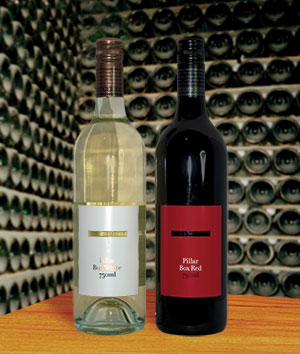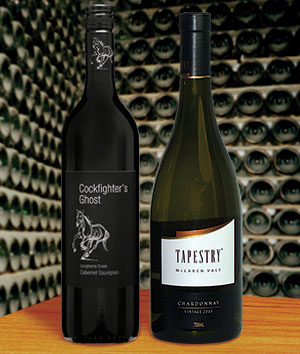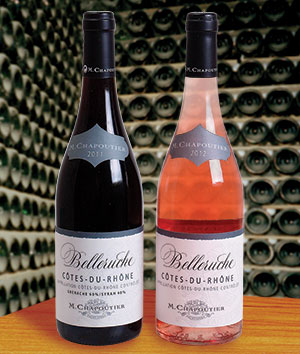
My Baby, She Wrote Me A Letter
And if my baby was Australian, she would have mailed it from a pillar box, which is what mail boxes are called Down Under as well as in England.
Pillar boxes lined the coach-driven mail routes, or ‘drives,’ established in the 1850s to provide mail service to the farmers and settlers then moving into southeastern South Australia. One such route in Padthaway was operated by Henry John Hill, and ran through property now owned by the third generation of the Longbottom family.
In 1992 Kim and Mark Longbottom decided to expand their farming operation into winemaking, and released their first offering in 1996. In a nod to the history of the mail route that once passed through the vineyards, today the family’s wine business is known as Henry’s Drive Vignerons.
The Padthaway region was once covered by the ocean. The receeding waters left behind a limestone subsoil topped by rich red loamy earth. This soil structure combines with good winter rains and mild sunny summers to make Padthaway well-suited for viticulture. The first vines were planted there in 1964, and it has come to be one of Australia’s premier wine-producing regions.
Pillar Box Red 2005
A blend of 57% cabernet sauvignon, 32% shiraz, and 11% merlot. The color is opaque purple, with a European-style flavor profile. The fruit is somewhat recessive, with nice astringency and enough tannin for structure. An excellent value, and 2005 is only the second vintage.
Pair this muscular wine with roasted or grilled beef or pork, blue cheese stuffed hamburgers, or a full-flavored, tomato sauced lasagna.
Pillar Box White 2006
A blend of 66% chardonnay, 20% sauvignon blanc, and 14% verdelho. The dominant taste is grapefruit, supported by lemon and citrus zest and racy, minerally acid. This makes for a tart, zippy, refreshing wine, ideal for this time of year. The color is pale straw yellow with a green tinge.
Try this wine with grilled or baked fish, a cheese course, shrimp on the barby (of course), or even tortilla chips and salsa.
This month’s wines are both sealed with screw caps. Screw caps have long been associated with low-quality wines. However, this has begun to change because of the perennial problem of “cork taint.” Cork taint is caused by complex chemical mechanisms triggered by the presence of microscopic fungi in the cork. Although not hazardous, cork taint does ruin the wine with a musty, wet cardboard smell and taste.
Screws caps are seen as a solution to this problem, and less tradition-bound Aussies are using them extensively on wines at every quality level. Commendable as that may be, I still prefer a cork, even if it is a well-made artificial one.
Top of page: https://winervana.com/blog/


 When it comes to wine aeration, I am an agnostic. I rarely aerate these days, and when I do I usually use a decanter. For me, decanting and waiting an hour or two offers the best chance of improving a wine’s flavor and aroma.
When it comes to wine aeration, I am an agnostic. I rarely aerate these days, and when I do I usually use a decanter. For me, decanting and waiting an hour or two offers the best chance of improving a wine’s flavor and aroma.
 The Russian River AVA sits in the center of northern California’s Sonoma County, and is characterized by a generally cool climate, with sunny days bracketed by fog early and late. This encourages the slow-ripening of fruit, particularly suitable for Chardonnay, Pinot Noir, and Sauvignon Blanc, like these selections from Mossback Winery.
The Russian River AVA sits in the center of northern California’s Sonoma County, and is characterized by a generally cool climate, with sunny days bracketed by fog early and late. This encourages the slow-ripening of fruit, particularly suitable for Chardonnay, Pinot Noir, and Sauvignon Blanc, like these selections from Mossback Winery. Truchard Vineyards was established in 1974, when native Texans Tony and Jo Ann Truchard purchased a 20-acre parcel of land in Carneros. They transformed what was an abandoned prune orchard into a vineyard, and began selling the fruit to a local winery. Because of the difficult clay soil he had to work with, as well as a dearth of groundwater, Truchard was one of the early adapters of drip irrigation, a practice that was used in Israel for desert farming but not known in California yet. The Truchard Estate Vineyard has since grown to 400 acres, of which 280 are planted.
Truchard Vineyards was established in 1974, when native Texans Tony and Jo Ann Truchard purchased a 20-acre parcel of land in Carneros. They transformed what was an abandoned prune orchard into a vineyard, and began selling the fruit to a local winery. Because of the difficult clay soil he had to work with, as well as a dearth of groundwater, Truchard was one of the early adapters of drip irrigation, a practice that was used in Israel for desert farming but not known in California yet. The Truchard Estate Vineyard has since grown to 400 acres, of which 280 are planted. California Girls
California Girls
 Going to California
Going to California
 Yo, Ho, Ho, and a Bottle (or two) of Rum
Yo, Ho, Ho, and a Bottle (or two) of Rum The Rhone Ranger
The Rhone Ranger Dakota Shy was founded by industry veterans Todd Newman and Tom Garrett in 2008, determined to ultimately create a world-class estate of their own. They began by sourcing Cabernet Sauvignon grapes from a range of vineyards throughout Napa Valley.
Dakota Shy was founded by industry veterans Todd Newman and Tom Garrett in 2008, determined to ultimately create a world-class estate of their own. They began by sourcing Cabernet Sauvignon grapes from a range of vineyards throughout Napa Valley. Every once in awhile I like to take a a wee nip of Scotch whiskey just as variety from the grape. So when I received word of this single malt, it seemed like an opportune time to tickle the taste buds. The Singleton of Glendullan is the object of interest here, and a fine example of Scotland’s most famous region for single malts, Speyside.
Every once in awhile I like to take a a wee nip of Scotch whiskey just as variety from the grape. So when I received word of this single malt, it seemed like an opportune time to tickle the taste buds. The Singleton of Glendullan is the object of interest here, and a fine example of Scotland’s most famous region for single malts, Speyside.